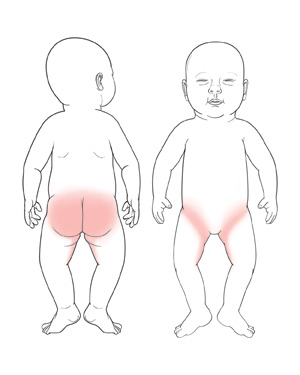Diaper Rash, Candida (Infant/Toddler)
 |
| Areas where Candida diaper rash can form. |
Candida is a type of yeast. It grows best in warm, moist areas. It's common for candida to grow in the skin folds under a child’s diaper. When there's an overgrowth of candida, it can cause a rash called a candida diaper rash.
The entire area under the diaper may be bright red. The borders of the rash may be raised. There may be smaller patches that blend in with the larger rash. The rash may have small bumps and pimples filled with pus. The scrotum in boys may be very red and scaly. The area will itch and cause the child to be fussy.
Candida diaper rash is most often treated with over-the-counter antifungal cream or ointment. The rash should clear up a few days after starting the medicine. Infections that don’t go away may need a prescription medicine. In rare cases, a bacterial infection can also take place.
Home care
Medicines
Your child’s healthcare provider will recommend an antifungal cream or ointment for the diaper rash. They may also prescribe a medicine to help relieve itching. Follow all instructions for giving these medicines to your child. Apply a thick layer of cream or ointment on the rash. It can be left on the skin between diaper changes. You can apply more cream or ointment on top, if the area is clean.
General care
Follow these tips when caring for your child:
-
Wash your hands well with soap and clean, running water before and after changing your child’s diaper and applying any medicine.
-
Check your child's diaper often. Change the diaper as soon as you notice it's soiled. Gently pat the area clean with a warm, wet soft cloth. If you use soap, it should be gentle and scent-free. Topical barriers, such as zinc oxide paste or petroleum jelly, can be used to help keep urine and stool from touching the skin.
-
Don’t over-clean the affected skin areas. This can irritate the skin further.
-
Don’t apply powders, such as talc or cornstarch, to the affected skin areas. Talc can be harmful to a child’s lungs. Cornstarch can cause the candida infection to get worse.
-
Change your child’s diaper at least once at night. Put the diaper on loosely.
-
Use a breathable cover for cloth diapers instead of rubber pants. Slit the elastic legs or cover of a disposable diaper in a few places. This will allow air to reach your child’s skin. Disposable diapers may be preferred until the rash has healed.
-
Let your child go without a diaper for periods of time. Exposing the skin to air will help it heal.
Follow-up care
Follow up with your child’s healthcare provider as directed.
When to get medical advice
Unless your child's provider advises otherwise, call the provider right away if your child:
-
Has a fever
-
Is fussier than normal or keeps crying and can't be soothed
-
Has symptoms that worsen or don’t get better with treatment
-
Develops new symptoms, such as blisters, open sores, raw skin, or bleeding
-
Has abnormal or bad-smelling fluid leaking in the affected skin areas
Fever and children
Use a digital thermometer to check your child’s temperature. Don’t use a mercury thermometer. There are different kinds and uses of digital thermometers. They include:
-
Rectal. For children younger than 3 years, a rectal temperature is the most accurate.
-
Forehead (temporal). This works for children age 3 months and older. If a child under 3 months old has signs of illness, this can be used for a first pass. The provider may want to confirm with a rectal temperature.
-
Ear (tympanic). Ear temperatures are accurate after 6 months of age, but not before.
-
Armpit (axillary). This is the least reliable but may be used for a first pass to check a child of any age with signs of illness. The provider may want to confirm with a rectal temperature.
-
Mouth (oral). Don’t use a thermometer in your child’s mouth until they are at least 4 years old.
Use the rectal thermometer with care. Follow the product maker’s directions for correct use. Insert it gently. Label it and make sure it’s not used in the mouth. It may pass on germs from the stool. If you don’t feel OK using a rectal thermometer, ask the healthcare provider what type to use instead. When you talk with any healthcare provider about your child’s fever, tell them which type you used.
Below are guidelines to know if your young child has a fever. Your child’s healthcare provider may give you different numbers for your child. Follow your provider’s specific instructions.
Fever readings for a baby under 3 months old:
-
First, ask your child’s healthcare provider how you should take the temperature.
-
Rectal or forehead: 100.4°F (38°C) or higher
-
Armpit: 99°F (37.2°C) or higher
Fever readings for a child age 3 months to 36 months (3 years):
-
Rectal, forehead, or ear: 102°F (38.9°C) or higher
-
Armpit: 101°F (38.3°C) or higher
Call the healthcare provider in these cases:
-
Repeated temperature of 104°F (40°C) or higher in a child of any age
-
Fever of 100.4° (38°C) or higher in baby younger than 3 months
-
Fever that lasts more than 24 hours in a child under age 2
-
Fever that lasts for 3 days in a child age 2 or older